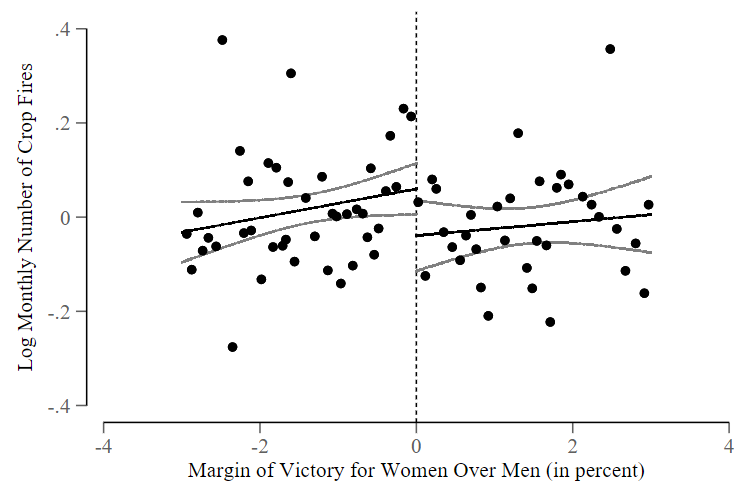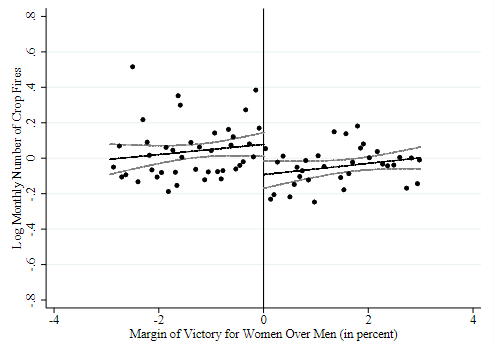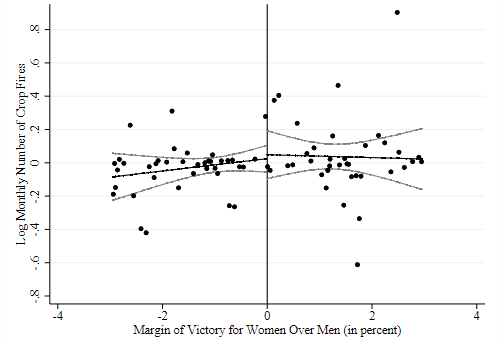
Female legislators decrease crop fire incidence and lower particulate emissions relative to male leaders - a survey suggests that female leaders are more likely to consider crop fires a serious issue, weigh their impacts on child health, and implement crop residue management policies
Editor's note: This article originally appeared on Ideas for India.
Given political deadlock in legislatures despite the extensive environmental degradation worldwide, proactive measures from local leaders could be crucial in addressing global issues like air pollution. However, despite the introduction of quotas for women in legislative assemblies in many countries (Pande and Ford 2012), as well as existing evidence that there exists a causal relationship between policy and identity (Osborne and Slivinski 1996, Besley and Coate 1997), and that women have a greater concern for the environment (McCright 2010, McCright and Dunlap 2011), we know extremely little about the impact of women leaders on local environmental outcomes. In a new study (Jagnani and Mahadevan 2023), we use data on fires in India and a close election regression discontinuity design to provide the first causal evidence that local women leaders improve environmental outcomes.1 To shed light on the reasons why women leaders reduce crop fire incidence, we surveyed 424 female and male village council leaders in Punjab, the state with the highest per capita incidence of crop fires in India.
How crop fires contribute to air pollution in India
Air pollution remains one of the leading causes of mortality, accounting for 9 million premature deaths annually (or roughly 16% of all deaths worldwide), and a staggering 268 million disability-adjusted life-years (Landrigan et al. 2018). Nowhere is the problem more pronounced than in India, which is home to 14 of the 20 most polluted cities in the world. In fact, if New Delhi were to meet World Health Organization air quality standards, average life expectancy in the city would increase by 10 years (Greenstone and Fan 2019), roughly equivalent to the gains in life expectancy made by the country on average in the 21st century (Roser et al. 2013). While there exist factors that contribute to the poor air quality throughout the year (such as vehicular emissions), crop fires are a seasonal but acute factor that contribute to as much as half of the total particulate pollution during the winter months (Cusworth et al. 2018, Bikkina et al. 2019, Shyamsundar et al. 2019).
Farmers in India use crop fires for three reasons: (i) clearing harvest residue off fields in preparation for planting in the next season; (ii) making sugarcane harvesting less labour-intensive; and (iii) clearing undergrowth on fields left fallow between cropping seasons. The use of fire is particularly prevalent in coupled rice-wheat cropping arrangements, which are widespread across India. In this system, farmers grow rice during the monsoon season (Kharif) from June to November, and wheat during the winter season (Rabi) from January to May. The narrow window of time between the harvest of rice (October-November) and the planting of wheat (December-January), and between the harvest of wheat (April-May) and planting of rice (June-July), requires large-scale and quick removal of crop residue, and setting fire to crop residue is particularly helpful in speeding this process.
Fire also plays a role in the production process for sugarcane, an important crop across the country. Farmers light sugarcane fields on fire to remove the outer leaves around the cane stalk to make the processing easier and less labour-intensive while harvesting the cane in the winter months. Finally, the use of fire is widespread along forest lands in central and north-east India among communities that follow patterns of shifting cultivation where farmers switch between alternate plots of land and fields are left fallow for more than a year. Undergrowth often overtakes fallow fields, which need to be cleared before the subsequent season's planting.
Although alternative mechanisms like employing seasonal labour and mechanised equipment are available to farmers, they prefer the use of fire because it is cheaper, despite the associated human health costs. Indeed, in our survey of 424 village council leaders in Punjab – a majority of whom earn their livelihood through agriculture – more than 50% of respondents said that the use of both labour and machines was more expensive, even though they recognised that crop fires negatively affect health outcomes.
Women’s representation in state legislative assemblies and incidence of crop fires
To examine the effect of women leaders on crop fire incidence, we use satellite data on the number of fires – as captured via NASA’s Terra and Aqua satellites – in state legislative assemblies across India; we compare assemblies where women narrowly won or lost elections against men from 1998 to 2022. The elected members of state legislative assemblies in India, known as MLAs, play a pivotal role in shaping public health and agricultural policies, influencing the allocation of federal funds to local administration for effective policy implementation, and overseeing the progress and enforcement of these policies. However, a glaring disparity exists in women's representation in federal and state politics in India. Recent statistics show that women’s representation hovers around a meager 10% (Beaman et al. 2012). This is significant also because female MLAs have distinct policy priorities, with a marked preference towards increased investments in child health and education, in contrast to their male counterparts (Clots-Figueras 2012, Bhalotra and Clots-Figueras 2014).
We find that the election of a female MLA over a male MLA in a close election decreases the number of fires by 13% (Figure 1) and monthly maximum biomass-related particulate emissions by 40%. The assumption underlying our research design is that no other differences exist between constituencies where women narrowly won over men and where women narrowly lost to men. Indeed, we find characteristics of elections (such as party affiliation, candidate’s education or number of votes) with a narrow female winner are similar to those of elections with a narrow female loser. Similarly, assemblies with a narrow female winner and those with a narrow female loser have similar characteristics in terms of electricity access, number of schools, etc.
Figure 1. Incidence of crop fires in all assemblies where women narrowly won or lost

Figure 2. Incidence of crop fires when women narrowly won or lost in assemblies with high (left panel) and low (right panel) rice and sugarcane


Notes: i) All graphs plot the regression discontinuity relationship for log of monthly fire counts. ii) High and low rice and sugarcane indicate assemblies which had high (above sample median) share of cropped area under rice or sugarcane at baseline and low (below sample median) share of cropped area under rice and sugarcane at baseline, respectively.
Furthermore, in a placebo test, we show that no differences exist in either fire incidence or particulate emissions prior to the close election victory of women over men. We also show that the decrease in fire incidence and particulate emissions are concentrated in districts that follow fire-suited cropping patterns (left panel of Figure 2), with comparatively modest effects in districts that do not follow fire-suited cropping arrangements (right panel of Figure 2). Lastly, the decrease in fire incidence and particulate emissions in districts that follow fire-suited cropping patterns is concentrated during the harvest and post-harvest months, with null effects during the rest of the year.
Women leaders’ response to crop fires
To shed light on why women leaders reduce crop fire incidence, we conducted telephonic surveys with 230 female and 194 male village council leaders (VCLs) in Punjab between December 2022 and March 2023. Unfortunately, it was not possible to schedule interviews with MLAs. However, VCLs share analogous roles and responsibilities at a more grassroots level. These local leaders are responsible for implementing state policies and discerning the needs of the villages they represent. While their primary financial backing comes from the state, they are, in theory, granted total autonomy in the disbursement of these funds. It is worth noting that Punjab ensures a 50% reservation for women in VCL elections, especially since prior evidence has shown that reservation for women causes an uptick in investments directed toward public goods benefiting women and children (Chattopadhyay and Duflo 2004, Beaman et al. 2007).
We find that women leaders are 20% more likely to consider crop fires a very serious problem, plausibly because they are more concerned about the health costs for children: we find women leaders are significantly more likely to be worried about child health impacts than male leaders. Accordingly, women leaders are more likely to strongly favour regulations to decrease the incidence of crop fire and are aware of a greater number of the policies implemented by the government to tackle this issue, such as penalties. Finally, women leaders are more likely to implement crop residue management policies like private residue collection or encouraging crop residue use as fodder. This is significant, as private residue collection has been shown to decrease the incidence of crop fires elsewhere (Nian 2023). These results are robust to controlling for differences in demographic characteristics between male and female VCLs such as education, age, and occupation.
Implications for economic development and environmental policy
The interplay between economic development and environmental policy presents complex challenges. As economies flourish, a surge in production and consumption ensues, which, at least initially, exacerbates pollution and environmental degradation. Merely formulating policies to counteract these adverse environmental externalities might fall short of achieving the desired impact, especially in contexts with weak regulatory institutions and inconsistent enforcement. What is crucial is the presence of dedicated leaders who are genuinely committed to implementing these policies on the ground. Our results suggest that enhancing women's political representation might help developing countries navigate existing and emerging environmental challenges.
This study was funded by the 2021 NBER Research Grants on Economic Shocks and Gender.
Note:
- Regression discontinuity is a quasi-experimental impact evaluation method that isolates the causal effect of a treatment by comparing outcomes just above and below a threshold – in this case, narrowly winning or losing the election – that determines treatment assignment.
References
Beaman, L, E Duflo, R Pande and P Topalova (2007), ‘Women Politicians, Gender Bias, and Policy-Making in Rural India’, The State of the World's Children, Background Paper.
Beaman, L, R Pande and A Cirone (2012), The Impact of Gender Quotas, Oxford University Press, Oxford.
Besley, Timothy and Stephen Coate (1997), “An Economic Model of Representative Democracy”, The Quarterly Journal of Economics, 112(1): 85-114.
Bhalotra, Sonia and Irma Clots-Figueras (2014), “Health and Political Agency of Women”, American Economic Journal: Economic Policy, 6(2): 164-197.
Bikkina, Srinivas, et al. (2019), “Air Quality in Megacity Delhi Affected by Countryside Biomass Burning”, Nature Sustainability, 2(3): 200-205.
Chattopadhay, Raghabendra and Esther Duflo (2004), “Women as Policy Makers: Evidence from a Randomized Policy Experiment in India”, Econometrica, 72(5): 1409-1443. Available here.
Clots-Figueras, Irma (2012), “Are Female Leaders Good for Education? Evidence from India”, American Economic Journal: Applied Economics, 4(1): 212-244.
Cusworth, Daniel H, et al. (2018), “Quantifying the Influence of Agricultural Fires in Northwest India on Urban Air Pollution in Delhi, India", Environmental Research Letters, 13(4).
Greenstone, M and QC Fan (2019), ‘India’s ‘War Against Pollution’: An Opportunity for Longer Lives’, Air Quality Life Index Report.
Jagnani, M and M Mahadevan (2023), ‘Women Leaders Improve Environmental Outcomes: Evidence from Crop Fires in India’, Working Paper. An overview of the paper is available here.
Landrigan, Philip J, et al. (2018), “Pollution and Global Health–An Agenda for Prevention”, Environmental Health Perspectives, 126(8): 084501.
McCright, Aaron M (2010), “The effects of gender on climate change knowledge and concern in the American public”, Population and Environment, 32: 66-87.
McCright, Aaron M and Riley E Dunlap (2011), “Cool dudes: The denial of climate change among conservative white males in the United States”, Global Environmental Change, 21(4): 1163-1172.
Nian, Yongwei (2023), “Incentives, penalties, and rural air pollution: Evidence from satellite data”, Journal of Development Economics, 161: 103049.
Osborne, Martin J and Al Slivinski (1996), “A Model of Political Competition with Citizen-Candidates”, The Quarterly Journal of Economics, 111(1): 65-96.
Pande, R and D Ford (2012), ‘Gender Quotas and Female Leadership’, Background Paper, World Bank.
Roser, M, E Ortiz-Ospina and H Ritchie (2013), ‘Life Expectancy’, Our World in Data Report.
Shyamsundar, P, et al. (2019), “Fields on Fire: Alternatives to Crop Residue Burning in India”, Science, 365(6453): 536-538.


